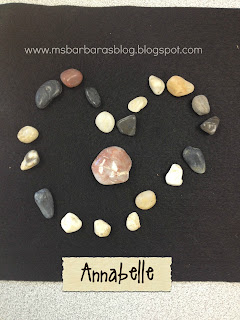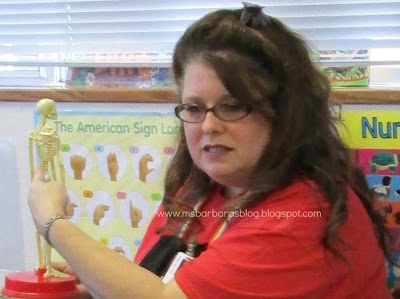 |
| Observing trees: identifying the roots, trunk, branches, and leaves; feeling the trunk; comparing the trunk to our hands; looking for insects and plants on the tree, and more. |
 |
| We did a litter pick-up around the preschool and our campus. |
 |
| We ended our day outside reading Miss Sadie McGee Who Lived in a Tree. |
 |
| The kids enjoyed it so much that they asked our parent volunteer, Ms. Melisa to read it to them again. |
 |
| My "green" tree t-shirt |
 |
| Ms. Shannon let us borrow her beautiful river rocks. |
 |
| I LOVE how this friend took the instructions literally. Notice how the colors match. |
 |
| We were able to borrow a rock collection from the elementary school and Ms. Shannon let us borrow her amazing Andy Goldsworthy book. |
 |
| Rock provocation: Each child creates their own work of art and we photographed their creation.   |
 |
| We then added the nature inspiration cards. |
 |
| Parent volunteer, Ms. Leslie brought in some rocks from her home. Love the mortar and pestle. She also identified where each rock was found. |
 |
| The kiddos especially enjoyed this rock, which looked like any other rock on the outside, but had beautiful white crystals that sparkled and looked like snow inside it. |
 |
| We used these two AMAZING rock books at our group times. |
 |
| After cleaning the rocks, each child got to hold a rock during the "If You Find a Rock" book reading. |
 |
| Ms. Myrna brought in a lava rock and a pumice stone. The kiddos were able to compare their weight then we did a sink or float experiment. Many of them were surprised that the pumice stone floated. |
 |
| We decided to make Earth crayons. The kiddos peeled blue and green crayons, broke them, then placed them in a small muffin tin. |
 |
| We placed them in a 200 degree oven until they were fully melted. We cooled them completely then sent them home with the kiddos the next day. |
 |
| LOVE IT!! She's got the whole world in her hands... |
 |
| I saw how Play at Home Mom LLC created their own homemade bird feeder from office supplies and items around the house and decided we'd try it. I found an office organizer at Walmart and the attachments there, as well. So far so good. |
 |
| Bird seed in, ready for the birds. |
 |
| I saw Juniper Moon Farm's suet feeder and decided to create our own Bird Nest Supply Station. We followed their guidelines of making sure the yarn was cut between 4 and 8 inches by placing rulers on the table and teaching the kiddos how to measure the yarn pieces. |
 |
| ...measuring carefully... |
 |
| ...filling up the suet feeder... |
 |
| ...we hung it in the tree. Ready for the birds. |
 |
| Our hummingbird feeder has seen LOTS of action. |
 |
| After seeing the nature chandelier's over at Fairy Dust Teaching, I knew we needed to create one for our classroom. We gave craft wire to each child and encouraged them to string the beads up to 12 inches. Once again, a measuring activity. |
 |
| If they put more than 12 inches, they could remove some of the items. |
 |
| Carefully beading...we also had lace and feathers available for their use. |
 |
| The end result! I am thrilled BEYOND WORDS!! |
 |
| We ended our week reading "One Love" by Cedella Marley, daughter of Bob Marley. After reading it we listened to the song. |
 |
| We did pause during the story as we heard flocks of Canada geese flying overhead. |
 |
| These were some of our AMAZING books we read during the week: The Busy Tree, Our Tree Named Steve, and One Love. Not pictured is A Grand Old Tree and BIG EARTH, Little Me. |
 |
| This is one of the newest crazes in the classroom: Frigits Deluxe or as we like to call them "Magnetic Marble Maze". We continue to have AMAZING adventures... |



























